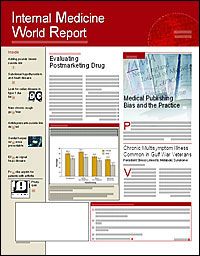Publication
Article
Internal Medicine World Report
Thiazolidinedione Therapy Boosts Exercise Function in Type 2 Diabetics
Author(s):
Investigators from the University of Colorado at Boulder have documented an improvement in exercise capacity in patients with type 2 diabetes who are ad?min?istered oral thiazolidinedione (TZD) therapy, according to data published in Diabetes Care (2005;28:2877-2883).
The results are drawn from a study in which 20 middle-aged patients with established uncomplicated type 2 diabetes were randomized to rosiglitazone (Avandia), 4 mg/day, or placebo. Rosiglitazone is a TZD that is commonly used to treat insulin resistance. Endothelial function, maximal oxygen consumption, oxygen uptake kinetics, and insulin sensitivity were measured at baseline and after 4 months of treatment.
"This is the first known report showing that a thiazolidinedione improved exercise function in type 2 diabetes," according to lead investigator Judith Regensteiner, PhD, director of the University of Colorado's Women's Center for Health Research, and colleagues.
Although regular exercise is a fundamental component of the management of type 2 diabetes, patients do not necessarily embrace the idea of participating in a routine exercise program. And even when there is no apparent cardiovascular disease, the ability of patients to perform maximal exercise is impaired. Such impair?ment is correlated with insulin resistance and endothelial dysfunction.
Previous research had demonstrated that rosiglitazone improved insulin sensitivity and that the TZD class improved endothelial function.
Baseline clinical and demographic characteristics were similar in both the TZD and placebo groups.
"The primary finding in the present study was that VO2max [maximal oxygen consumption] improved in patients with type 2 diabetes after the administration of a thiazolidinedione," according to the inves?tigators, while VO2max did not improve with placebo.
As expected, insulin sensitivity (as determined by homeostasis model assessment and a hyperinsulinemic-euglycemic clamp) also improved with rosiglitazone.
Key points
Exercise is an important component of diabetes management.
Patients’ ability to exercise is impaired by a reduced VO2max and other disease-related physiologic dysfunction.
TZDs appear to improve exercise capacity in diabetic patients.
Endothelial function, which was determined by brachial ultrasound measurement of brachial diameter, was significantly improved in the rosiglitazone group but not in the placebo group.
The investigators could not identify the mechanisms responsible for the improved exercise capacity, noting that additional research is needed.
In an accompanying editorial (pages 2975-2977), Nathan K. Le Brasseur, PhD, and Neil B. Ruderman, MD, of Boston University School of Medicine, agree that the study demonstrates that TZDs can do more than improve insulin sensitivity; they also improve exercise capacity in patients with type 2 diabetes.
They were quick to add, however, that the increase in exercise capacity was modest and that rosiglitazone's usefulness in improving exercise capacity may be limited, that >4 months of treatment may be needed, and that early treatment may provide greater benefits.





